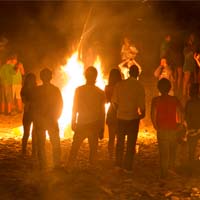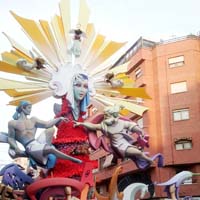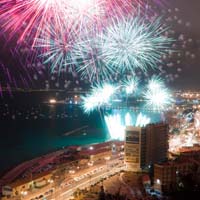St. John's Bonfires
Many cultures have honored this date in a very special way since Neolithic times, and keep doing so nowadays. Although the celebration and its rites have a pre-Christian origin, in Christianity it is associated with the birth of John the Baptist. In Alicante, the feast of St. John's Bonfires represents this tradition.
Midsommer, Festa Junina, Sobótki, Enyovden, Ivanje, Sankt Hans aften, Jaanik, Jóansøka, Ukon juhla, Szentiván-éj, Sommersonnenwende, Fête de Saint-Jean, Jāņi, Joninės, Jonsok, Noc Świętojańska, Drăgaica, Ivanjdan, Midsommarafton, Gŵyl Ifan… The Midsummer festivity can have many names, depending on the country where it’s celebrated, but what the name list confirms is that we’re talking about a widespread celebration that takes place in a lot of different places around the 23rd of June. The festivity is associated with fertility and earth cycles, as well as with purification rites and, also, related to the astrological event that takes place on that day, the summer solstice. The presence of fire is a constant in all cultures, and is the central element of the celebration.
Celebration

In Spain, the most notable of the solstice celebrations takes place in Alicante, also a well-know destination for sun and beach tourism by the Mediterranean Sea. Although this type of celebration also happens in many other Spanish cities, the Bonfires of Saint John, as Alicante’s feast is officially called, has been considered a Festival of International Tourist Interest. Though lighting bonfires and letting fireworks off were common practice in the celebration of the solstice in Alicante, the city’s council forbid these practices for some years, due to the chaos that took control of the town during that night. Until 1881, when the council forgot to renew the edict that prohibited these activities and the feast as we know it today began its history.
Two different fire-related events take place in this Spanish coastal city on the night of June 23rd, and that is why the word Bonfire (hoguera) has two different senses in this event: one, the bonfires by the seaside, and two, the bonfires consumed in the Cremà, the burning of the so called Ninots. The first type, the bonfires, consists of spontaneous gatherings on Alicante’s beaches on the evening of the 23rd of June. The ritual is pretty much the same as in any other Midsummer celebration in the world, that is, the pagan ritual that has been happening for thousands of years: the bonfires are lit (they used to be made of old furniture and useless objects) and people gather round them, sing songs, drink and dance... It is said by the locals that one has to jump over the fire three times to cleanse and purify yourself, and also that if you write a wish on a piece of paper and throw it into the bonfire, your wish will come true.

But it is the Cremà, what’s really outstanding in the Bonfires’ festivity. Inspired by the Fallas of Valencia, in 1928 Alicante started creating its own Ninots, enormous wood and paper-mache statues representing caricatures of celebrities, politicians, or satirical depictions of the recent news’ events. The bonfires are a proper art show. They are exhibited on the streets of Alicante from June 20th (la Plantá) until the night of the 23rd, when they are burnt in a big event completed by a huge fireworks display from Santa Barbara’s Castle hill. During those days, a contest is held to choose the winners of each year’s edition, a great privilege for the commission that built the elected statues, which receive the privilege of being the last to be reduced by the fire. The bonfires’ style differs from the Valencian Fallas’ sculptures, the former being more influenced by modernism and with a more avant-garde character in their forms and colors. There are 86 commissions, and each creates one sculpture for the contest. The commissioners (foguerers) also organize different events -both throughout the whole year and on the days of the festivity- in order to gather funds for next’s years St. John's Bonfires event. During the 3 days of the feast they also set up the racós (a sort of hut) with tables and chairs for people to cool down and have something to eat or to drink. Outside the foguerers’ guild, other associations also set up the so called barracas, which have the same goal as the racós.

Apart from the Bonfires, other activities, like the huge fireworks palm tree that’s grows from the city’s castle hill, and the Mascletá, a very typical activity in the Mediterranean area of Spain, which consists of thousands of firecrackers being set off at the same time for a few minutes. Another big part of the celebrations is centered on the Beauties (Belleas), the most representative element of the feast after the bonfires. There are both older (18-25 years old) and younger (9-11 years old) Beauties, one for each commission, which makes a total of 86 Beauties and 86 Infantile Beauties. From all these candidates one queen is elected, and she receives the very sought after title of Bellea del Foc (Beauty of the Fire), a title that brings both a great honor and a great responsibility with it.
Music bands are constantly parading the streets of Alicante during these 3 days, as the Valencian Community is known to be very fond of music. Each guild hires a music band to offer the crowd amusement and entertainment day and night throughout the five days of celebrations. There are also bullfights taking place on St. John’s and St. Peter’s days, rounding up the celebration of one of the main events in popular festivities in Spain, the St. John's Bonfires in Alicante.

 Let the sacred fire purify the world! This is more or less what happens every June in the city of Alicante, a seaside attraction and the capital of flames!
Let the sacred fire purify the world! This is more or less what happens every June in the city of Alicante, a seaside attraction and the capital of flames! 